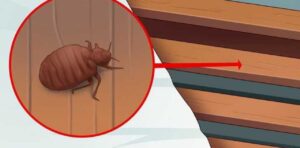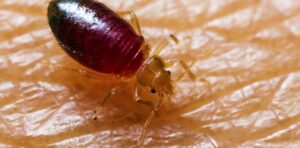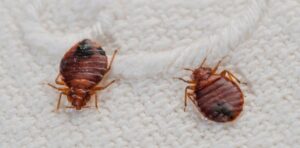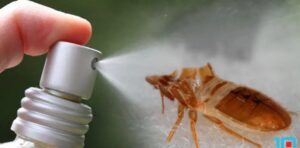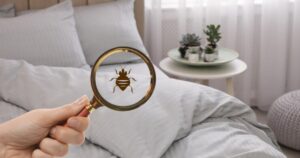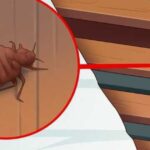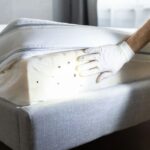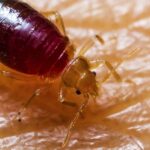Welcome to our informative guide on the topic of bed bugs and their resemblance to lint. For those seeking a sense of belonging within a community concerned about household pests, this article aims to shed light on the physical characteristics of bed bugs and their similarities to lint, while also highlighting the key differences between the two.
We will discuss the signs of a bed bug infestation and provide guidance on how to properly identify these insects. If you suspect the presence of bed bugs in your home, it is essential to take immediate action. By following the steps outlined in this guide, you can effectively address any potential bed bug infestation and ensure a peaceful, pest-free living environment.
Key Takeaways
- Bed bugs and lint can both appear as small, dark specks, making them difficult to spot.
- While they can be found in similar locations like bedding and furniture, bed bugs have distinct physical characteristics and can move, while lint is stationary and has a fibrous texture.
- Bed bugs have an oval-shaped body with six legs and two antennae, while lint lacks any discernible body structure.
- Bed bugs are living organisms that can leave behind fecal stains or blood spots and can bite humans, causing itchy welts, while lint is simply small fibers that have detached from fabrics and does not move, leave stains, or bite.
Physical Characteristics of Bed Bugs
Bed bugs possess distinct physical characteristics that set them apart from other pests. While they may share some similarities with ticks, such as their small size and flat bodies, bed bugs can be easily distinguished by their reddish-brown color and oval-shaped bodies. Measuring only about the size of an apple seed, bed bugs are visible to the naked eye but can often go unnoticed due to their ability to hide in various places.
Common hiding spots for bed bugs include seams and crevices of mattresses, box springs, bed frames, and even behind wallpaper. They are also known to hide in cracks and crevices in furniture, electrical outlets, and baseboards. Identifying these physical characteristics and knowing their common hiding places is crucial in effectively dealing with a bed bug infestation.
Similarities Between Bed Bugs and Lint
When it comes to appearance, there are some similarities between bed bugs and lint. Both can be small and difficult to spot with the naked eye. Additionally, both bed bugs and lint can be found in similar areas, such as beds, sofas, and clothing. However, it is important to note that while lint is harmless, bed bugs, unlike lint, can cause significant discomfort and infestation issues. Identifying bed bugs can be challenging due to their small size and ability to hide in crevices, whereas lint is easily distinguishable by its fibrous texture and lack of movement. Keep in mind that bed bugs can even live on leather surfaces.
Appearance Similarities: Bed Bugs & Lint
There are notable similarities in appearance between bed bugs and lint. At first glance, both bed bugs and lint can appear as small, dark specks. They can also be found in similar locations, such as on bedding or in clothing fibers. However, there are important distinguishing features that set bed bugs apart from lint. Bed bugs are actually small insects, whereas lint is made up of fibers from fabric or other materials.
Bed bugs have a distinct, oval-shaped body with six legs and two antennae, while lint lacks any discernible body structure. Additionally, bed bugs are capable of moving, while lint is stationary. Understanding these differences is crucial for identifying and addressing potential bed bug infestations.
Identification Challenges: Bed Bugs Vs. Lint
One of the primary challenges in identifying bed bugs versus lint lies in the similarities between their physical characteristics. Both bed bugs and lint can appear as small, dark specks, making it difficult to distinguish between the two. Additionally, both bed bugs and lint can be found in similar locations, such as on bedding, furniture, and clothing. This similarity in appearance and habitat can lead to confusion when trying to determine whether the presence is due to bed bugs or lint.
To distinguish between lint and bed bugs, it is important to consider other factors. Bed bugs are living organisms, whereas lint is composed of fibers. Bed bugs can move and may leave behind fecal stains or blood spots on bedding or furniture. They are also capable of biting humans, causing itchy welts. In contrast, lint does not move, leave stains, or bite.
Understanding these differences will help in accurately identifying and addressing infestations of bed bugs versus lint. In the following section, we will explore the specific differences between bed bugs and lint.
Differences Between Bed Bugs and Lint
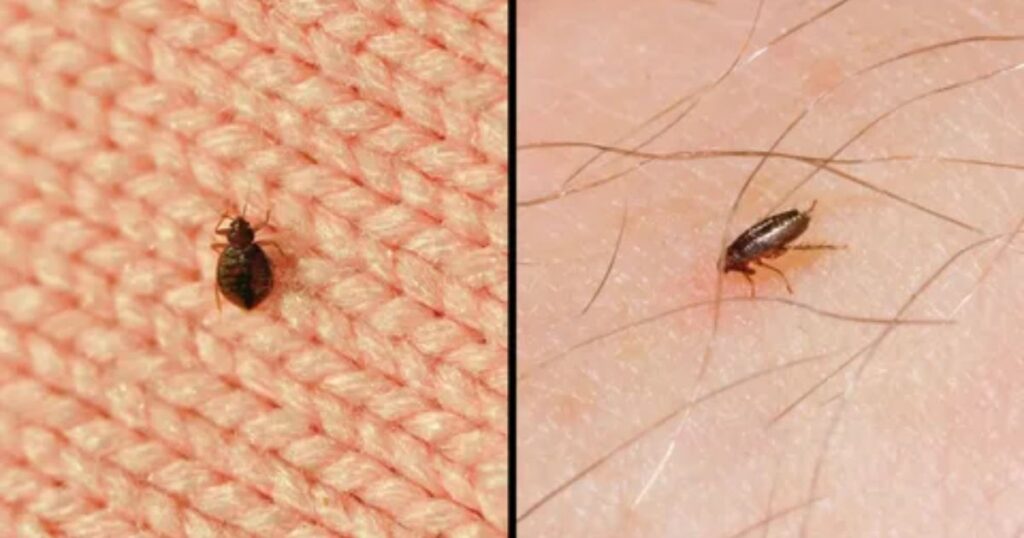
Bed bugs and lint can be easily distinguished from each other based on their physical characteristics. While lint is simply small fibers that have detached from fabrics, bed bugs are small, wingless insects that feed on blood. To further highlight the differences between bed bugs and lint, the following table provides a visual comparison:
| Physical Characteristics | Bed Bugs | Lint |
|---|---|---|
| Shape | Oval | Irregular |
| Size | 4-5 mm | Varies |
| Color | Brownish | Various shades |
From the table, it is evident that bed bugs have a distinct oval shape, are larger in size (4-5 mm), and typically have a brownish color. On the other hand, lint can vary in shape, size, and color, making it less uniform in appearance. Understanding these differences can help individuals identify whether they are dealing with bed bugs or simply lint.
Signs of a Bed Bug Infestation
What are the telltale signs of a bed bug infestation? Identifying the signs of a bed bug infestation is crucial in order to take prompt action and prevent further infestation. Visual inspection techniques can be employed to detect the presence of bed bugs. One common sign is the appearance of small, reddish-brown spots on bedding, mattresses, or furniture, which are fecal stains left behind by the bugs.
Another visual indicator is the presence of molted exoskeletons or shed skins, as bed bugs shed their skin as they grow. Additionally, blood stains on sheets or pajamas may indicate bed bug bites. It is also important to look for live bed bugs, which are small, flat, oval-shaped insects that are about the size of an apple seed. By being aware of these signs and employing visual inspection techniques, individuals can effectively identify and address a bed bug infestation.
How to Properly Identify Bed Bugs
To properly identify bed bugs, it is important to understand their physical characteristics and employ visual inspection techniques. Bed bugs are small, oval-shaped insects that are reddish-brown in color and have flat bodies. They can be detected through careful examination of bedding, furniture, and other potential hiding places, looking for signs of their presence such as dark spots, shed skins, or live bugs. Visual inspection plays a crucial role in accurately identifying bed bugs and taking appropriate measures for control and prevention.
Physical Characteristics of Bed Bugs
One can easily identify bed bugs by examining their physical characteristics, as they possess distinct features that differ from other common pests. To properly identify bed bugs, it is important to consider the following:
- Size and Shape:
- Adult bed bugs are approximately the size of an apple seed, measuring about 5-7 millimeters in length.
- They have an oval-shaped body with a flat and reddish-brown appearance.
- Coloration and Texture:
- Bed bugs have a distinct reddish-brown color, which turns darker after feeding.
- Their bodies are covered in tiny hairs, giving them a slightly fuzzy or velvety texture.
Visual Inspection Techniques
When conducting a visual inspection to properly identify bed bugs, it is important to employ thorough techniques and rely on professional methods. Visual inspection is crucial as it allows for early detection and effective treatment, minimizing the risk of infestation. However, identifying bed bugs can be challenging due to their small size and ability to hide in tiny cracks and crevices. To assist in the identification process, the following visual inspection techniques can be employed:
| Technique | Description |
|---|---|
| Flashlight | Use a bright flashlight to illuminate potential hiding spots, such as mattress seams, bed frames, and furniture joints. |
| Magnifying Glass | A magnifying glass can help in examining small areas for signs of bed bugs, such as eggs, nymphs, or excrement. |
| Visual Markings | Look for tell-tale signs like reddish-brown stains on bedding, molted exoskeletons, or live bugs crawling.
Steps to Take if You Suspect Bed Bugs

If you suspect bed bugs, take immediate action to prevent further infestation. Bed bugs are tiny, elusive pests that can quickly multiply and infest your home. Here are some steps you can take if you suspect bed bugs:
- Conduct a thorough inspection: Look for signs of bed bugs, such as blood stains, dark spots, or discarded exoskeletons, on your mattress, bedding, and furniture.
- Wash and dry infested items: Launder your bedding, clothing, and curtains in hot water and dry them on high heat to kill any bed bugs.
- Vacuum regularly: Vacuum your mattress, carpet, and furniture to remove bed bugs and their eggs.
- Use bed bug-proof encasements: Cover your mattress and box spring with encasements to prevent bed bugs from infesting them.
- Reduce clutter: Declutter your home to eliminate hiding places for bed bugs.
- Seal cracks and crevices: Seal any cracks or crevices in your walls, furniture, or baseboards to prevent bed bugs from hiding there.
FAQ’s
What is the bug that looks like lint?
The bug that looks like lint is often the carpet beetle, which is small and covered in tiny hairs, resembling lint or fuzz.
Do bed bug eggs look like lint?
Bed bug eggs are typically tiny, oval-shaped, and translucent, resembling small pieces of rice, rather than lint.
Are bed bugs visible to the naked eye?
Yes, bed bugs are visible to the naked eye, ranging in size from about 1 to 7 millimeters, depending on their life stage.
Conclusion
In conclusion, while bed bugs may bear some similarities to lint in terms of appearance and size, they can be distinguished through their distinct physical characteristics. It is important to be aware of the signs of a bed bug infestation and to properly identify these pests to effectively address the issue. Taking immediate action if you suspect bed bugs is crucial in order to prevent further infestation and potential health risks.


